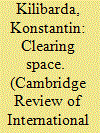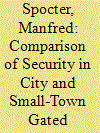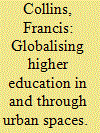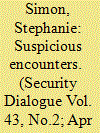|
|
|
Sort Order |
|
|
|
Items / Page
|
|
|
|
|
|
|
| Srl | Item |
| 1 |
ID:
109171


|
|
|
|
|
| Publication |
2011.
|
| Summary/Abstract |
This article examines recent shifts in Belgrade's urban geography and built environments, with an accent placed on landscapes of social cleansing, gentrification and commercialization accompanying Serbia's emerging neoliberal governmentality. It does so by exploring the convergent translocal discourses and institutional structures that provided financing, conditionality and legitimacy for the forcible displacement of a sizeable Roma community living under Belgrade's Gazela Bridge and their involuntary relocation into housing containers on the city's outskirts in late August 2009. The article juxtaposes the violence of this site-specific biopolitical intervention into Roma everyday life, which was executed by local city authorities and financed by European financial institutions, with the alternative strategies deployed by the community and its allies in contesting Belgrade's racialized urban restructuring. The Gazela episode illustrates how functional re-inscriptions of urban space for the translocal needs of capital can simultaneously generate both violent cartographies of dispossession and precarious forms of subaltern reterritorialization.
|
|
|
|
|
|
|
|
|
|
|
|
|
|
|
|
| 2 |
ID:
183680


|
|
|
|
|
| Summary/Abstract |
Gated developments are a defining feature of the post-apartheid residential landscape. The fortification practices witnessed in gated developments are part of a wider securitisation of the South African urban- and ruralscapes. This research resides in the ambit of the theory of crime and violence as a precursor to the growth in gated developments. Research on gated developments has tended to focus on their proliferation in larger urban settlements, with scant attention being paid to gated developments in smaller settlements and in rural areas. However, non-metropolitan gated developments are a reality, and they display similar security features as those found in metropolitan areas. This paper compares the security levels of gated developments in a suburb of Cape Town with those in small towns in the Western Cape province. Security features are quantified to determine whether differences in securitisation levels exist between the locales. The gated developments in the city display higher levels of security than those in small towns. However, a closer analysis of small-town gated developments reveals high security levels in towns where tourism is the mainstay of the local economy. As the technology of security migrates from military applications to residential applications, a securified small-town future is a real possibility.
|
|
|
|
|
|
|
|
|
|
|
|
|
|
|
|
| 3 |
ID:
134167


|
|
|
|
|
| Publication |
2014.
|
| Summary/Abstract |
This paper explores the connections between universities and cities in a moment of heightened emphasis on international student mobilities and globalising processes in Asian higher education. In particular, I seek to draw attention to the contingent assembly of the urban and its role in globalising higher education by highlighting the ways in which urban spaces draw together different sorts of trans-local connections and flows. To explore this approach, I discuss the globalisation of higher education in South Korea, and the significance of Seoul in these processes through a focus on two leading universities - Korea University and Seoul National University. To highlight the importance of trans-local connections in the urban dimensions of higher education, I discuss the generation of desires to be mobile in imaginations of Seoul as a destination for higher education, student experiences of situated learning in place and the articulation of student mobilities into career pathways with Korean transnational firms. From this perspective urban spaces need to be understood as much more than just the geographical backdrop to the globalisation of higher education. Rather, cities like Seoul are the spaces through which connections are being forged around knowledge production, international migration and trans-local economic practices.
|
|
|
|
|
|
|
|
|
|
|
|
|
|
|
|
| 4 |
ID:
181330


|
|
|
|
|
| Summary/Abstract |
Narratives of the Indian revolutionary movement in exile have often focused on abstract notions of ‘London’—with a particular focus on ‘India House’ in Highgate—or ‘Paris’ without taking into account specific geographies of Indian anti-colonialism within these imperial metropoles. Drawing on addresses provided in intelligence reports, this article takes a spatial approach and explores how particular areas of London and Paris enabled the development of the Indian revolutionary movement in exile in the early twentieth century.
|
|
|
|
|
|
|
|
|
|
|
|
|
|
|
|
| 5 |
ID:
112738


|
|
|
|
|
| Publication |
2012.
|
| Summary/Abstract |
Photographers have become common targets of security practice in the public spaces of US and UK cities. The securitization of photography - where photographers are commonly stopped, questioned, told to surrender film or delete photos, and in some cases arrested - rests upon the invocation of a post-9/11 context and the preemptive security logics that characterize the 'war on terror'. Here, the spatio-temporality of the photograph and the photo-taking subject are in tension with preemptive security stances in which everyday, ordinary actions - such as photography - are rendered suspicious and worthy of potential intervention. Using examples of specific encounters between photographers and security personnel, this article interrogates the conduct of these interventions and the preemptive security stance that scopes ordinary actions and everyday urban spaces through flexible and dispersed acts. Finally, the article considers how this uncoordinated and dispersed practice travels across a wide variety of actors without clear, causal linkages. The practice is a mobile, circuitous one, and through its analysis the article argues for more attention to be paid to everyday, embodied, and dispersed practices of preemption.
|
|
|
|
|
|
|
|
|
|
|
|
|
|
|
|
|
|
|
|
|